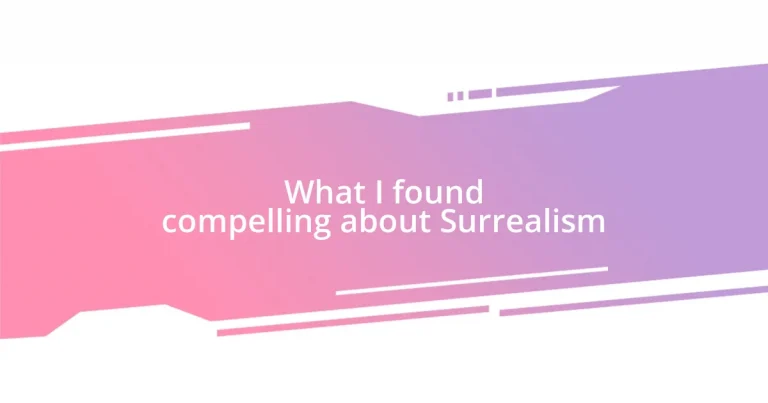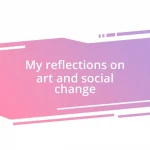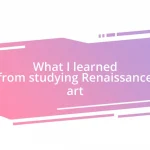Key takeaways:
- Surrealism explores the unconscious mind and challenges perceptions of reality, influenced by Freud’s psychoanalysis and emphasizing techniques like automatic drawing and dream analysis.
- Key Surrealist artists like Salvador Dalí and René Magritte utilized innovative approaches to provoke thought and question reality, blending the bizarre with the ordinary.
- Modern surrealism continues to impact various media, encouraging a dialogue on personal creativity and expanding our understanding of reality and the subconscious.
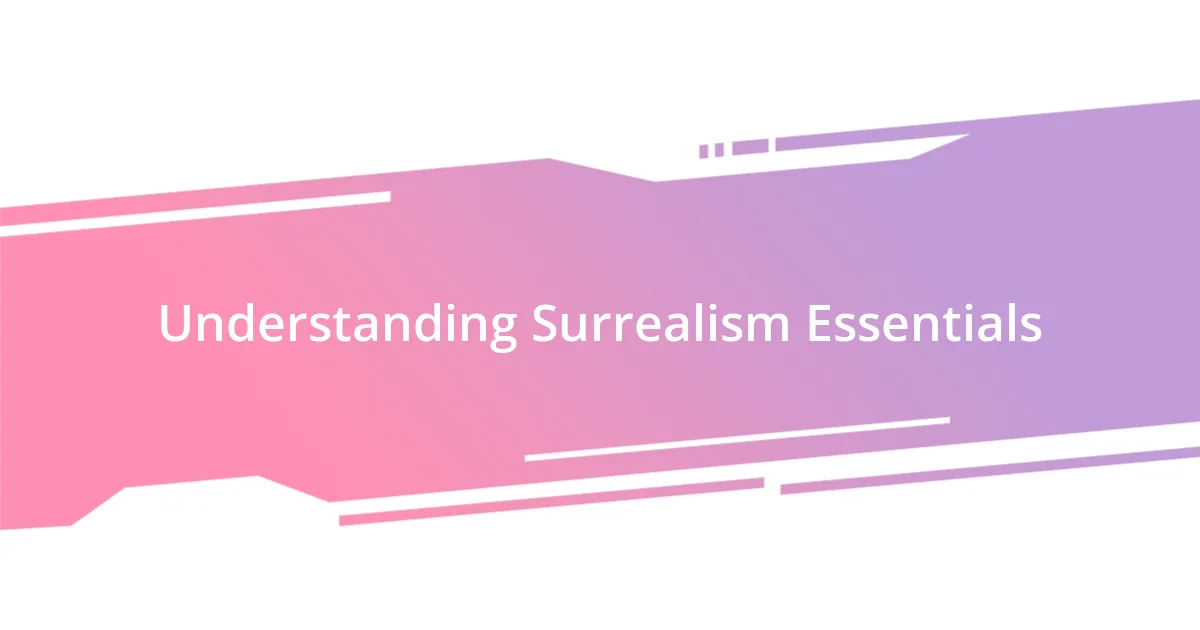
Understanding Surrealism Essentials
Surrealism, at its core, is about exploring the unconscious mind and challenging the conventional perception of reality. I remember the first time I encountered Salvador Dalí’s “The Persistence of Memory”—the melting clocks captivated me, making me question the nature of time itself. Isn’t it fascinating how a simple image can evoke such complex thoughts and emotions?
Understanding the essentials of Surrealism involves recognizing its roots in psychoanalysis, particularly the theories of Sigmund Freud. When I learned about the significance of dreams and the subconscious, it struck me how these elements create a bridge between our innermost thoughts and artistic expression. Have you ever thought about what your dreams say about you? Surrealists invite us to embrace this realm of the bizarre to discover deeper layers of ourselves.
The techniques employed by Surrealist artists, such as automatic drawing and collage, are fascinating methods to unleash creativity. I’ve experimented with automatic writing myself, allowing thoughts to flow without judgment, and it can be liberating! It serves as a reminder that art doesn’t have to follow strict rules; instead, it can be an open dialogue with our subconscious, filled with unexpected surprises. Isn’t it thrilling to think that our imagination holds such power?
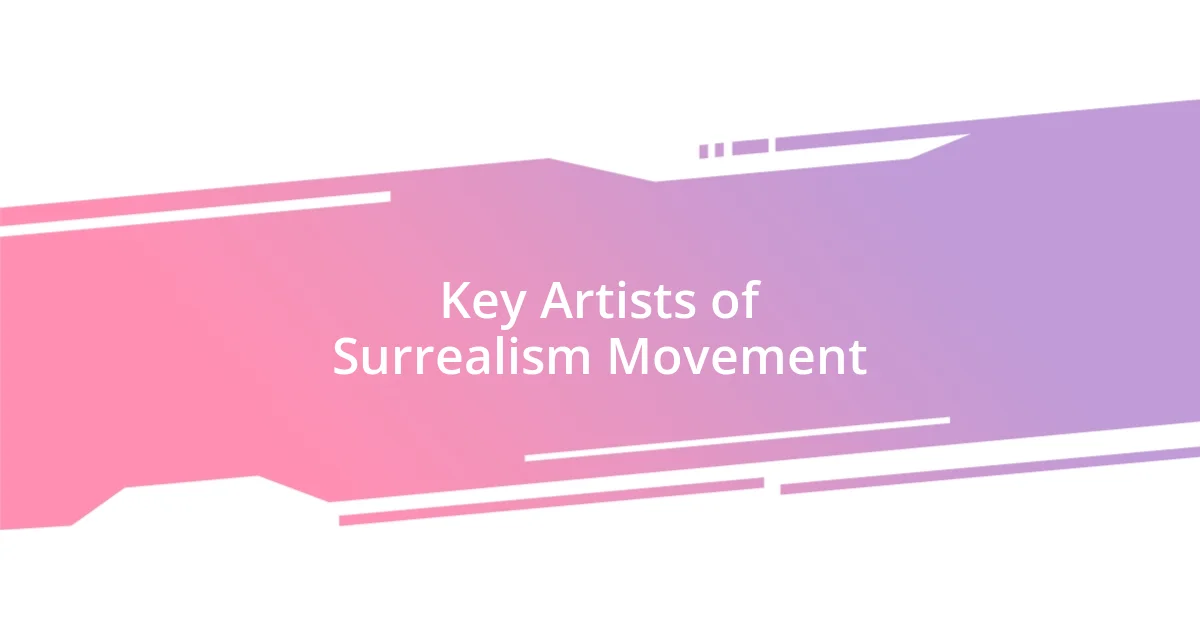
Key Artists of Surrealism Movement
The Surrealism movement was marked by several key artists whose innovative approaches continue to inspire. For instance, René Magritte, with his thought-provoking imagery, often played with the viewers’ perceptions of reality. I remember the first time I saw “The Treachery of Images,” where the phrase “Ceci n’est pas une pipe” (This is not a pipe) made me rethink how language and images relate to our understanding of the world.
Here are some prominent artists you should know:
– Salvador Dalí: Known for his eccentric personality and iconic works like “The Persistence of Memory.”
– René Magritte: Master of visual puns and illusions, he challenges viewers’ interpretations.
– Max Ernst: Pioneered techniques like frottage and collage, merging the tangible with the dreamlike.
– André Breton: A key figure in literature and theory, he articulated Surrealism’s ethos.
– Joan Miró: His playful style incorporates whimsy and abstraction, evoking a dreamlike state.
Each artist brought a unique perspective to Surrealism, contributing to a tapestry of ideas that continues to resonate. Reflecting on their work makes me appreciate how they encourage us to perceive more than just the surface; it’s about engaging deeply with the unconventional.
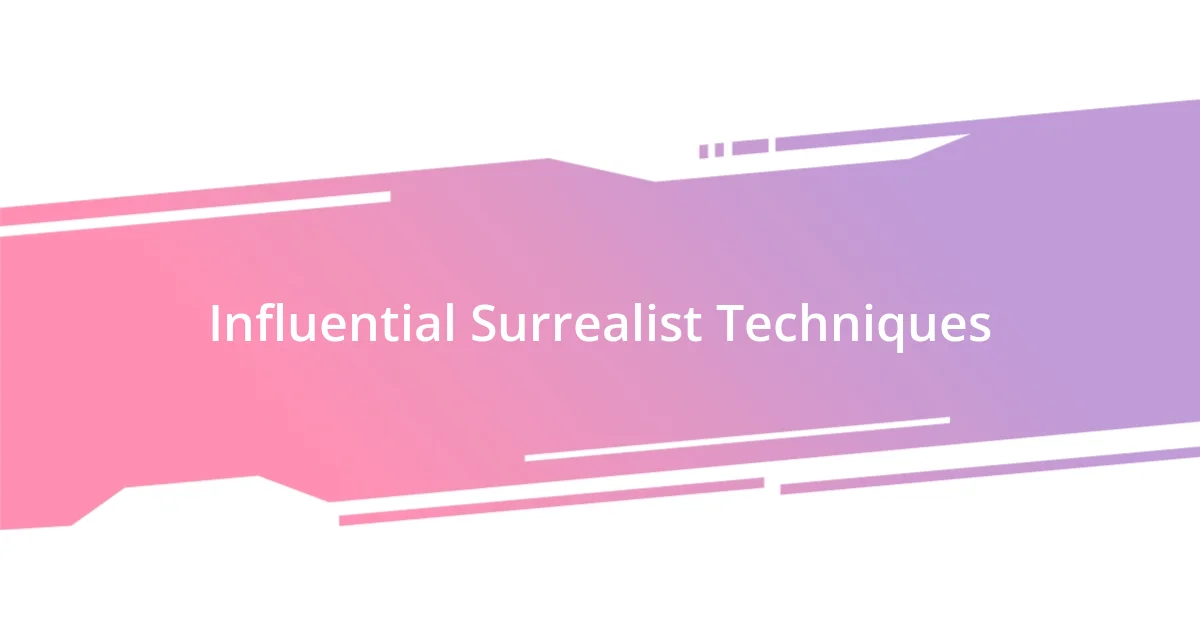
Influential Surrealist Techniques
The techniques used by Surrealists are both intriguing and impactful, each aiming to unlock the door to the subconscious. Take, for example, automatic drawing—a technique I tried during an art workshop. I simply let my hand move across the page without planning, which led me down unexpected paths. The experience was astonishing, as I discovered hidden symbols that seemed to echo my thoughts and feelings. It’s like giving your imagination a chance to speak freely.
Another fascinating technique is photomontage, where artists combine photographs to create surreal scenes. When I first saw a work by Hannah Höch, I was struck by her clever manipulation of images to challenge societal norms. The jarring contrasts in her compositions pushed me to see familiar subjects in unfamiliar ways, awakening a sense of curiosity. How do these techniques stir emotions and provoke thought? They ignite a conversation between the artist and the observer, inviting everyone to explore meaning beyond the surface.
Lastly, dream analysis played a crucial role in Surrealist techniques. I remember discussing dreams with friends, and how each bizarre scenario revealed something profound about our fears and desires. This connection between dreams and art teaches us that the surreal isn’t just for canvas—it’s a vital part of our daily lives. It’s thrilling to think that every night we might dream up a new artistic landscape filled with meaning worth exploring.
| Technique | Description |
|---|---|
| Automatic Drawing | Letting the hand move freely, tapping into unconscious thoughts. |
| Photomontage | Combining photographs to create dreamlike, sometimes jarring imagery. |
| Dream Analysis | Exploring dreams as a gateway to understanding the unconscious mind. |
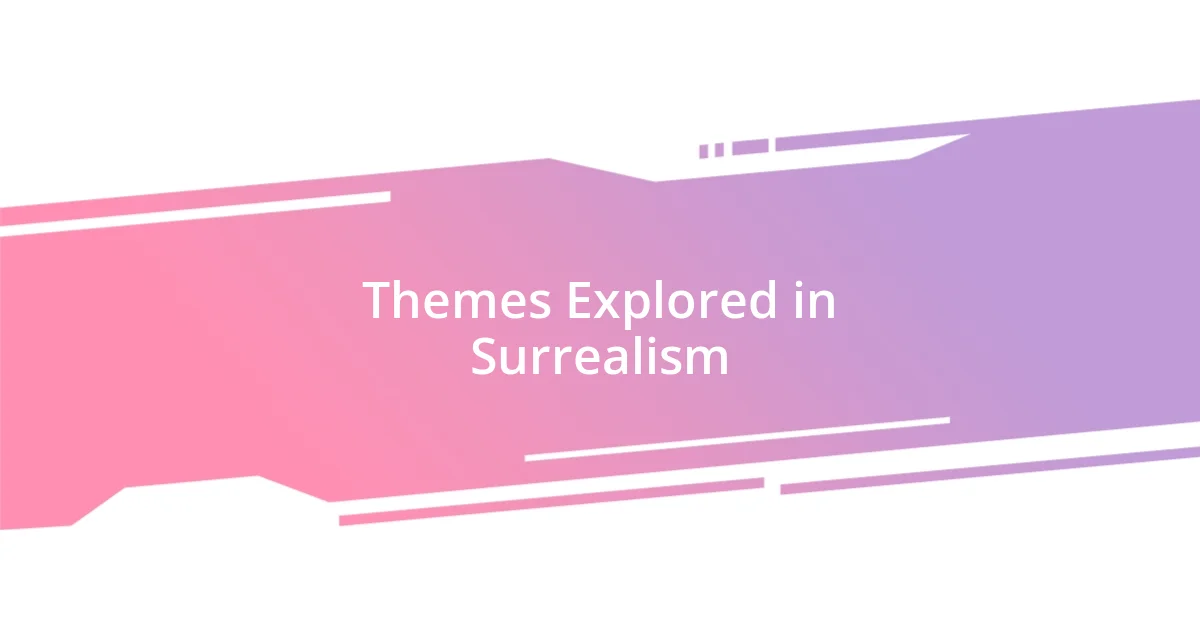
Themes Explored in Surrealism
Surrealism delves into the complexities of the human psyche, a theme that resonates deeply with me. The exploration of dreams and the subconscious often evokes profound emotions, revealing underlying anxieties and desires. I once kept a dream journal, and rereading those entries felt like deciphering a personal code. Isn’t it fascinating how our dreams can reflect our waking lives in unexpected ways?
Another compelling theme in Surrealism is the clash between reality and the absurd. The works often challenge our perceptions, prompting me to question the very nature of existence. I recall staring at a Dalí painting, feeling both bewildered and captivated. How does one reconcile the bizarre with the ordinary? This blending of extremes invites viewers to rethink their understanding of logic and experience.
Identity and transformation also play significant roles in Surrealist art. The fluidity of identity is something I find particularly compelling, as it encapsulates our ever-evolving selves. When observing artworks like Magritte’s, I’m struck by how they confront our sense of self. The questioning of who we are, or who we could be, sends me on a reflective journey. Isn’t that what art should do? Prompt us to explore the layers and complexities of our own identities?
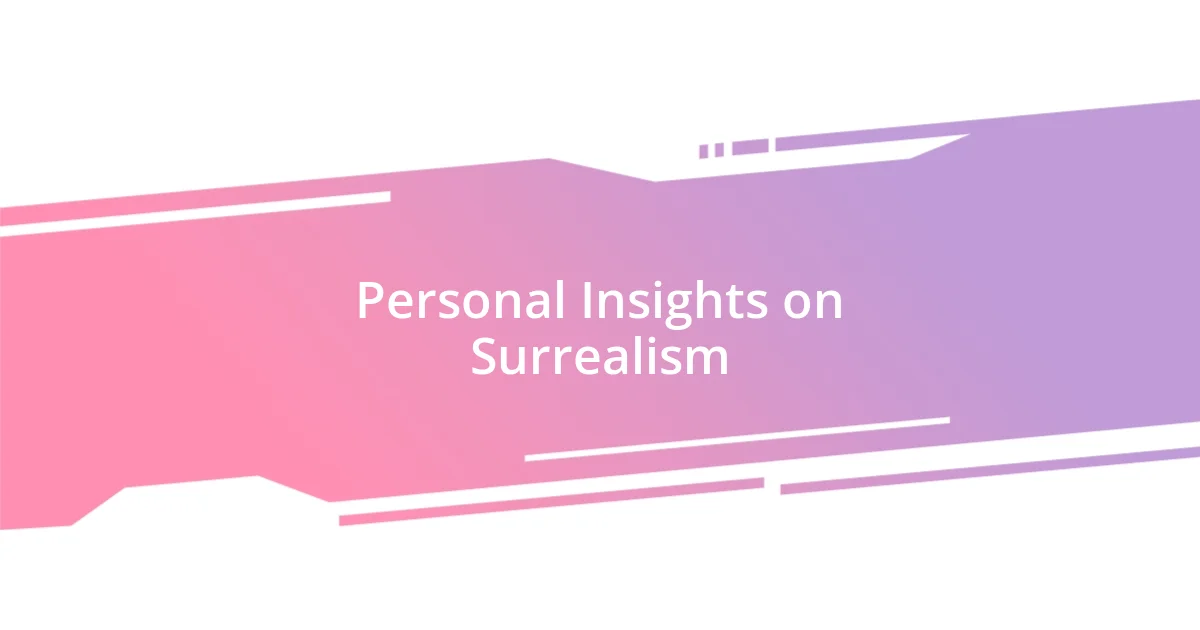
Personal Insights on Surrealism
Surrealism resonates with me on a deeply personal level, particularly because of its ability to unearth emotions I didn’t know I had. I remember attending a gallery opening, completely mesmerized by a large-scale painting that seemed to bend reality. Standing there, I felt as if I was peering into my own mind, grappling with hidden fears and desires. Isn’t it extraordinary how art can create a mirror reflecting our innermost thoughts?
One of the most compelling aspects of Surrealism is its invitation to embrace chaos instead of shying away from it. I recall experimenting with collage art shortly after being introduced to surreal techniques, cutting out images and letting them collide without any premeditation. The outcome was bizarre yet striking, reminding me that beauty often lies in the unexpected. This aligns perfectly with the question: Why do we fear unpredictability in art and in life?
The interplay of memory and imagination in Surrealism constantly captivates my thoughts. During a quiet evening, I found myself sketching ideas that merged my childhood memories with fantastical elements. As I traced the lines of my pencil, I realized how powerful these connections could be. How often do we allow our memories to wander freely, just like our dreams? This blend of the real and the imagined enriches my understanding of both the artwork and my own life stories.
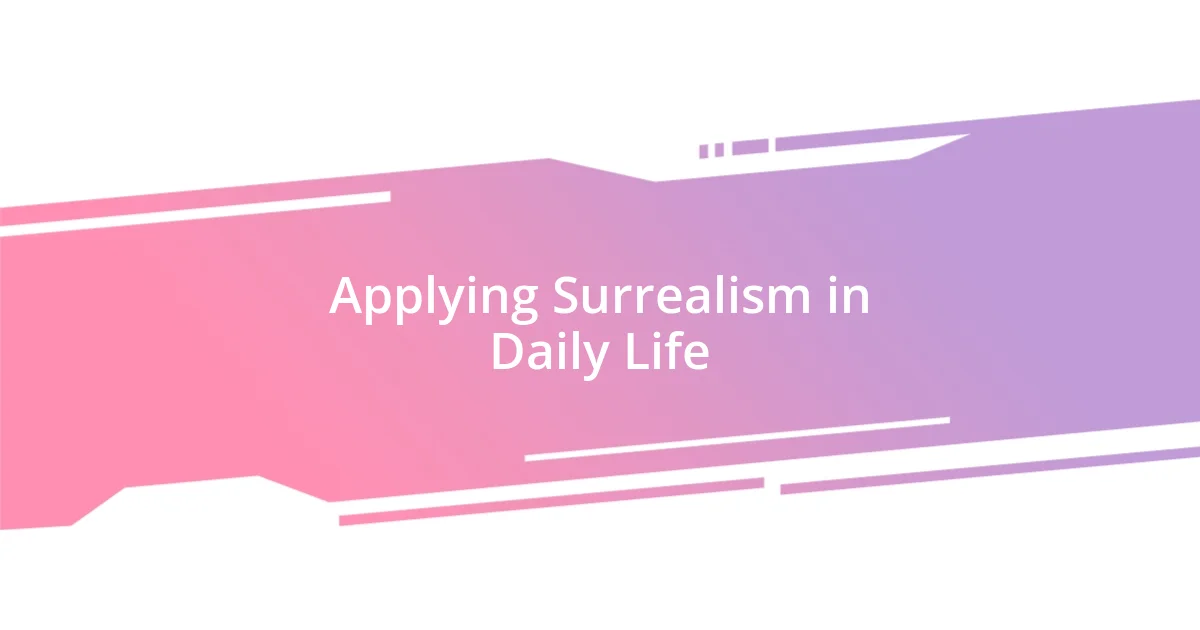
Applying Surrealism in Daily Life
Incorporating Surrealism into my daily life feels like a delightful adventure. I started finding inspiration in mundane routines by twisting them with whimsical thoughts. For instance, I began viewing my walk to work as a surreal journey, imagining each passerby as a character from a fantastical story. How often do we let our imaginations spill over into our ordinary experiences?
I also found joy in creating spontaneous art projects based on absurd ideas. One afternoon, I gathered random objects from my home—a rubber duck, a playing card, and an old photograph—and crafted a bizarre but eye-catching display. This little exercise reminded me of the Surrealists’ passion for unexpected juxtapositions. Why not invite chaos into our creativity and see what surprises await?
By embracing elements of surprise, I often stumble upon moments that feel surreal in their own right. The other day, I opened my refrigerator to find leftovers organized in an absurd symmetrical pattern, which struck me as both funny and peculiar. This moment sparked a new appreciation for the oddities of my everyday life. Isn’t it amazing how a touch of surrealism can transform the ordinary into something extraordinary?
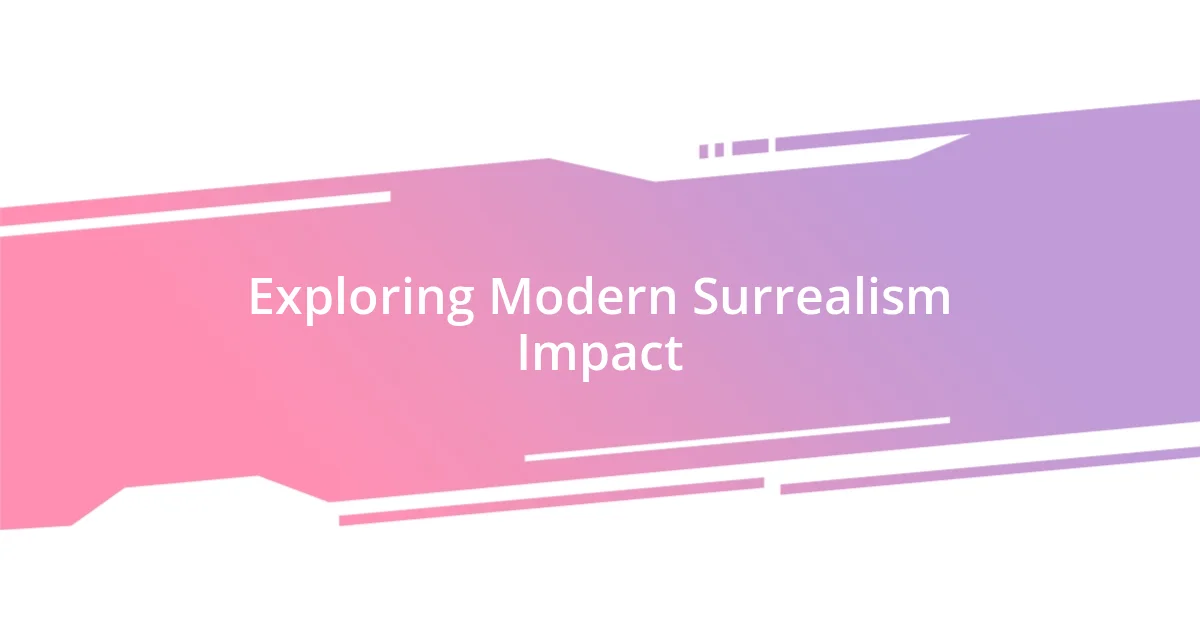
Exploring Modern Surrealism Impact
Absolutely, I find the impact of modern surrealism to be quite profound. One of the most significant influences I’ve noticed is how it challenges our perceptions of reality. I remember flipping through a contemporary art magazine when I stumbled upon a piece that playfully defied logical understanding. It made me wonder: how often do we allow our rigid views to dictate our experiences? This artwork pushed me to contemplate multiple interpretations rather than seeking a single meaning, showcasing how modern surrealism continues to encourage a dialogue about our understanding of the world.
Moreover, I’ve seen how modern surrealism seeps into various forms of media, from film to graphic novels. I recently watched a movie that seemed to blend dreamscapes with stark realities, leaving me in a state of introspection long after the credits rolled. How refreshing is it to see storytelling that mirrors the complexities of our subconscious? This intertwining of imagination with everyday life resonates deeply, reminding me that we all harbor a rich inner world waiting to be explored.
On a more personal note, engaging with modern surrealism has allowed me to embrace my own creativity without fear of judgment. I vividly recall a workshop where we were asked to create dream maps—visualizations of our aspirations and emotions. It felt liberating to let go of conventional constraints and add elements from my wildest dreams. Why do we often shy away from expressing our deepest fantasies? By exploring these unconventional thoughts, I felt a renewed sense of purpose, illustrating how modern surrealism empowers both artists and admirers to tap into the extraordinary facets of existence.












